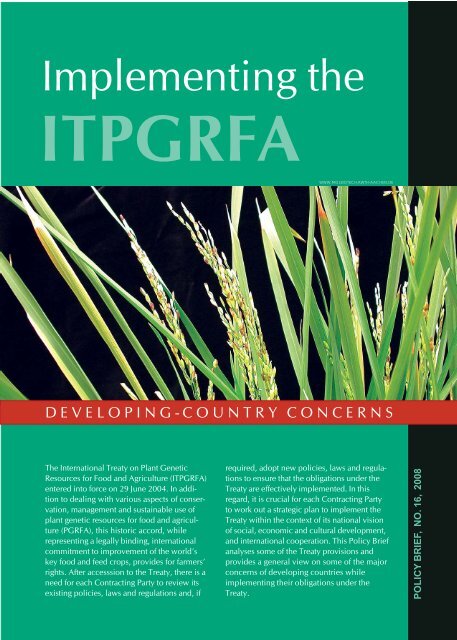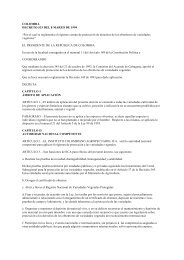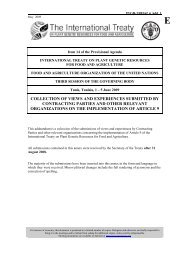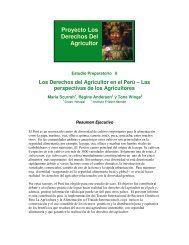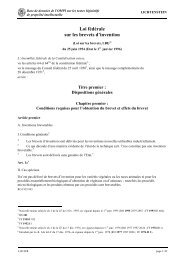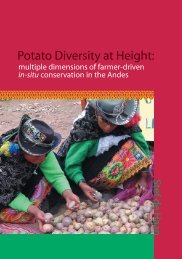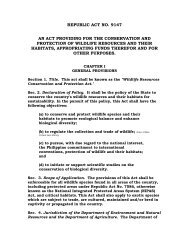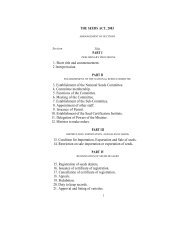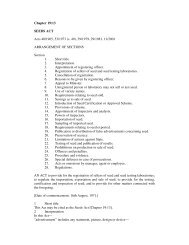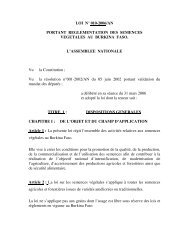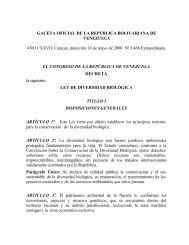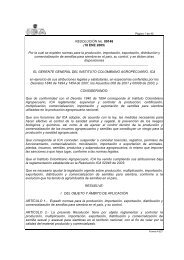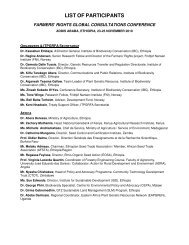itpgrfa - Farmers' Rights website
itpgrfa - Farmers' Rights website
itpgrfa - Farmers' Rights website
Create successful ePaper yourself
Turn your PDF publications into a flip-book with our unique Google optimized e-Paper software.
Implementing theITPGRFAPOLICY BRIEFWWW.MOLBIOTECH.RWTH-AACHEN.DEDEVELOPING-COUNTRY CONCERNSThe International Treaty on Plant GeneticResources for Food and Agriculture (ITPGRFA)entered into force on 29 June 2004. In additionto dealing with various aspects of conservation,management and sustainable use ofplant genetic resources for food and agriculture(PGRFA), this historic accord, whilerepresenting a legally binding, internationalcommitment to improvement of the world’skey food and feed crops, provides for farmers’rights. After accesssion to the Treaty, there is aneed for each Contracting Party to review itsexisting policies, laws and regulations and, ifrequired, adopt new policies, laws and regulationsto ensure that the obligations under theTreaty are effectively implemented. In thisregard, it is crucial for each Contracting Partyto work out a strategic plan to implement theTreaty within the context of its national visionof social, economic and cultural development,and international cooperation. This Policy Briefanalyses some of the Treaty provisions andprovides a general view on some of the majorconcerns of developing countries whileimplementing their obligations under theTreaty.POLICY BRIEF, NO. 16, 20081
2POLICY BRIEFImplementing the TreatyAfter more than 15 sessions of the Committee on Genetic Resourcesof the Food and Agriculture Organization of the UnitedNations (FAO) and its subsidiary bodies, the ITPGRFA was approvedduring the FAO Conference in 2001. The Treaty was introducedto harmonize the International Undertaking on Plant GeneticResources signed in 1983 with the Convention on BiologicalDiversity (CBD) (Box 1). As of the end of July 2007, 113 countries,92 of which are developing countries, have acceded to the Treaty.As a Contracting Party, each country has to ensure the conformityof its laws, regulations and procedures with its obligations asprovided in the Treaty.Most developing countries have a key thrust of increasing productivity,competitiveness and value addition in agriculture, agrobasedprocessing and agribusinesses; enhancing the capacity forknowledge and innovation; generating new wealth in knowledgeintensivefuture industries, particularly biotechnology productsand specialty natural products; reducing poverty, particularlythrough assisting rural community in marginal areas in the managementand use of biodiversity for improved livelihoods and foodsecurity; and strengthening international cooperation in the conservationand use of plant genetic resources (PGRs).It is, therefore, vital for such countries to adequately understandthe nature, scope and objectives of the ITPGRFA; assess theirstrengths and weaknesses in the implementation of the ITPGRFA;and strategically work out the effective mechanisms that theyneed to devise for the implementation of the Treaty, as well as forthe achievement of their national development objectives.Conservation and sustainable use of PGRFAThe core of the ITPGRFA is the national obligation under Articles 5and 6 on conservation and sustainable use of PGRFA. The efficientand effective implementation of measures and approachesidentified in these two Articles will certainly assist developing countriesin their efforts to achieve national development objectives.However, the first consideration is to what extent the implementationof such measures and approaches can enrich the genepools of crops essential for national food security and agriculturalproductivity. There is, thus, a need to develop a national plan fora systematic and timely enrichment of gene pools of crops essentialfor national food security, particularly with regard to possibleadverse impacts of climate change on agricultural productivity. Inthis process, it is crucial for the national plan to look for options tocapitalize on emerging opportunities and manage resources toenrich crop gene pools. For example, new technological tools haveopened up a number of opportunities for the enrichment of cropgene pools through the transfer of useful genes from relatedspecies and genera or any living organism but developing countrieswill have to be able to generate resources and enhance theirnational capacities to capitalize on such opportunities. Also crucialfor them is to assess the impacts of the implementation of accessand benefit sharing (ABS) and intellectual property right (IPR)rules on the flow of germplasm exchange.Since developing countries will have to put more emphasis onenriching crop gene pools through local genetic resources, it isimportant that the implementation of measures under Articles 5and 6 be further strengthened. Special consideration must beBox 1: About the CBDNegotiated under the auspices of the United NationsEnvironment Programme (UNEP), the CBD opened forsignature on 5 June 1992 at the Rio Earth Summit, andentered into force on 29 December 1993. The Convention islegally binding and Contracting Parties are obliged toimplement its provisions. So far, 190 countries and theEuropean Community are its members. The Convention hasthree objectives—the conservation of biological diversity,the sustainable use of its components, and the fair andequitable sharing of the benefits arising from the utilizationof genetic resources. It also addresses issues relating toresearch and training, public education and awareness, andtechnical and scientific cooperation.Article 15 of the Convention provides a framework for theimplementation of ABS. In recognition of the sovereignrights of states over their biological resources, nationalgovernments, subject to their national laws, are conferredthe authority to determine access to genetic resources. TheConvention requires its Parties to create conditions, subjectto allowed safeguards, to facilitate access to geneticresources for environmentally sound uses by other Partieson a bilateral basis.Adapted from: UNEP/CBD (2003).given to the survey and inventory of PGRFA that are of potentialuse; assessment and minimization of any threats to them; collectionof PGRFA and the relevant associated information on thosePGRs that are under threat or are of potential use; support forfarmers and local communities in in situ management and conservationof their PGRFA; support for in situ conservation of wild croprelatives and wild plants for food production; development of anefficient and sustainable system of ex situ conservation, puttingmore emphasis on field collections of tree crops; and more supportfor documentation, characterization, regeneration and evaluationof the ex situ collections.Conservation and sustainable use of PGRs are a long-term planningand implementation exercise. The general timeframe todevelop new crop cultivars is 15–30 years. The Treatyhas provided some strategic measures and approachesfor this long-term framework. Within the framework,the actions for implementing the measures and approachesmay include:ITPGRFA sets up a multilateralsystem of ABS, and its applicationis limited to such 64PGRFA that are fundamental tofood security and agriculture.
• formulating a National Breeding Action Plan to realize thestrategic economic development objectives/targets of agricultureand industries;• establishing a stable, predictable source of fund such as aNational Biodiversity and Gene Fund to support in situ andex situ conservation;• organizing an efficient network of ex situ conservationsites, gene banks, and research collections;• establishing a National Management System to manageboth in situ and ex situ collections;• providing financial and extension support to indigenousand local communities to manage in situ sites;• promoting the expanded use of local varieties andunderutilized species;• formulating and implementing seed laws on quality of plantingmaterials;• promoting private-sector investment in the conservationof genetic resources and the development of new cultivarsthrough the provision of tax incentives to any natural andlegal person who contributes to the National Biodiversityand Gene Fund, conserves genetic resources, producesand markets conservation varieties, including traditionalvarieties, and produces or manufactures products fromconservation varieties, including traditional varieties.regard, actions that have to be taken to implement the MLS andthe SMTA include:• placing into the MLS the PGRFA of Annex 1 crops that areunder the management and control of the government andin the public domain;• informing all legal and natural persons to use the SMTA forfacilitated access to PGRFA in the MLS;• informing/inviting all other holders of the PGRFA of Annex 1crops to put their PGRFA into the MLS;• providing for the MLS in national access legislation.Equally important is the implementation of Articles 7 and 8 of theTreaty on international cooperation and technical assistance, particularlymeasures that will lead to increased utilization of adaptedgene pools for the development of new cultivars. The geneticmaterials in the MLS have to be made useful to the breeders. Thelack of resources and expertise at the national level for the enrichmentof crop gene pools calls for collective efforts at regionaland global levels. This process of transferring genes fromunadapted raw materials to adapted gene pools that are useful tobreeders would require international technical cooperation as envisagedunder Articles 7 and 8. In this respect, national plans ofdeveloping countries need to include the following actions:POLICY BRIEFAccess to plant germplasmThe other important element of the Treaty is the establishment ofan international framework for the exchange of crop plantgermplasm chosen on the basis of food security and interdependence.This Multilateral System of Access and Benefit Sharing(MLS) under Part IV of the Treaty is an important internationalinstrument for the provision of access to PGRFA for the gene poolenrichment of Annex 1 crops at the global level. The first meetingof the Governing Body of the Treaty on 16 June 2006 adopted theStandard Material Transfer Agreement (SMTA) for the MLS. In this• strengthening regional and global cooperation on conservation,evaluation, documentation, genetic enhancement, plantbreeding, seed multiplication, and access to and exchangeof PGFRA—particularly PGRFA of underutilized crops, of cropswith functional values for nutrition, and of crops with economicvalue for the development of new industries;• strengthening the provision of South-South technical assistance.Benefit sharing in the multilateral systemThe SMTA is the most important instrument in the day-to-dayoperation of the MLS to facilitate access to PGRFA. It provides arate, and modalities, of payment for the sharing of monetarybenefits arising from commercialization. However, the MLS doesnot have any day-to-day operational mechanisms for the exchangeof information as provided under Article 13.2(a); access to and transfer of technology under Article13.2 (b); and capacity building under Article13.2 (c). The lack of such day-to-day operational mechanismswill surely heighten the concerns and reluctance ofdeveloping countries to place their PGRFA collections of Annex 1crops under the MLS.The Governing Body of the IT may have to work out such mechanismsunder international cooperation and technical assistance asenvisaged under Articles 7 and 8 of the Treaty. Without such dayto-dayoperational mechanisms, the MLS would not be fair andequitable to most developing countries.CO.SAINT-CROIX.WI.USFarmers’ rightsA number of resolutions were adopted by the FAO Conferenceon Farmers’ <strong>Rights</strong>. FAO Conference Resolution 4/89 recognizes“the enormous contribution that farmers of all regions have madeto the conservation and development of plant genetic resources,which constitute the basis for plant production throughout the3
world, and which form the basis for the concept of Farmers’<strong>Rights</strong>".Following this, the definition of farmers’ rights was adopted throughFAO Conference Resolution 5/89 as “rights arising from the past,present and future contribution of farmers in conserving, improvingand making available plant genetic resources, particularly thosein the centres of origin/diversity. These rights are vested in theInternational Community, as trustees for present and future generationsof farmers, for the purpose of ensuring full benefits offarmers and supporting the continuation of their contributions".The FAO Conference also adopted a resolution for the implementationof farmers’ rights. Resolution 3/91 provided “that Farmers’<strong>Rights</strong> will be implemented through an international fund on plantgenetic resources which will support plant genetic conservationand utilization programmes, particularly, but not exclusively, inthe developing countries”. However, in 1993, the FAO Conferencerecognized the need to take further steps to realize farmers’rights and adopted Resolution 7/93 to request the Director-Generalof the FAO to provide a forum for negotiations among governmentson, inter alia, the issue of the realization of farmers’rights.The negotiation on the realization of farmers’ rights was long anddifficult. Discussions began during the process of adopting theGlobal Plan of Action (GPA) for the Conservation and SustainableUtilization of Plant Genetic Resources for Food and Agriculture.The debate was whether farmers’ rights is just a concept or it canbe realized as ownership rights like plant breeders’ rights (PBRs)or the stewardship rights of farming communities over their PGRs(See FAO 1996).PGRFA and their sustainable use; confirming the needs and individualrights of farmers and, collectively, where recognized bynational law, to have non-discriminatory access to germplasm,information, technologies, financial resources and research andmarketing systems necessary for them to continue to manage andimprove genetic resources; and developing and/or strengtheningpolicies and legislative measures, as appropriate, to promote fairand equitable sharing of benefits arising from the utilization ofPGRFA in their exchange between communities and within theinternational community”. Here, it should also be noted that oneof the long-term objectives of supporting on-farm managementand improvement of PGRFA is “to realize Farmers’ <strong>Rights</strong> as definedin FAO Resolution 5/89 at the international, regional, andnational levels”.After such developments at the Leipzig Conference, the internationalcommunity got the basis for the negotiation of Article 9 onfarmers’ rights in the ITPGRFA. The negotiation on farmers’ rightsin the Treaty was, however, difficult. The most difficult issue wasthe conflict between PBRs and the rights that farmers have inrelation to saving, using, exchanging and selling farm-saved seeds/propagating materials. Finally, Article 9 was adopted with provisionsfor farmers' rights in its sub-articles (Box 2).Though Sub-article 9.3 of the Treaty provides for a negative rightfor farm-saved seeds/propagating materials, Article 9, as a whole,is one of the most important ITPGRFA provisions where ContractingParties have given due recognition to the enormous contributionthat the local and indigenous communities and farmers of allregions of the world have made for food and agricultural production.POLICY BRIEFIt was at the final hour that the Fourth International Conferenceon Plant Genetic Resources, which was held in Leipzig, Germanyfrom 17 to 23 June 1996, adopted a text stipulating that one ofthe main aims of the GPA is “to promote a fair and equitablesharing of the benefits arising from the use of plant genetic resourcesfor food and agriculture, recognizing the desirability ofsharing equitably benefits arising from the use of traditional knowledge,innovations and practices relevant to the conservation ofThe decision of implementing farmers’ rights under ITPGRFA, however,rests with national governments. If national governmentsdecide to do so, the processes of legislation and implementationof legislation are enormous tasks for policy-making and implementingbodies. There are a few models that national governmentscan follow but experimenting with new models is difficultand costly, especially in developing countries where there is a lackof capacity, expertise and resources (See IDRC-IPGRI-DHF 2001).Box 2: Provisions on farmers' rights in Article 9 of the ITPGRFAArticle 9 of the ITPGRFA has the following sub-articles onfarmers' rights:9.1 The Contracting Parties recognise the enormous contributionthat the local and indigenous communities and farmers ofall regions of the world, particularly those in the centers oforigin and crop diversity, have made and will continue to makefor the conservation and development of plant geneticresources which constitute the basis of food and agricultureproduction throughout the world.each Contracting Party should, as appropriate, and subject toits national legislation, take measures to protect and promoteFarmers’ <strong>Rights</strong>, including: (a) protection of traditionalknowledge relevant to plant genetic resources for food andagriculture; (b) the right to equitably participate in sharingbenefits arising from the utilisation of plant genetic resourcesfor food and agriculture; and (c) the right to participate inmaking decisions, at the national level, on matters related tothe conservation and sustainable use of plant geneticresources for food and agriculture.9.2 The Contracting Parties agree that the responsibility forrealising Farmers’ <strong>Rights</strong>, as they relate to plant geneticresources for food and agriculture, rests with nationalgovernments. In accordance with their needs and priorities,9.3 Nothing in this Article shall be interpreted to limit anyrights that farmers have to save, use, exchange and sell farmsaved seed/propagating material, subject to national law andas appropriate.Source: FAO (2002).54
6POLICY BRIEF5LI-BIRDSome proposals for implementing the various elements of farmers’rights include the intellectual use and protection of traditionalknowledge (TK) (Chart 1).TK has been used to develop new resources or products which areprotected by the conventional IPR systems. Similarly, at the resourceside, new plant varieties can be protected by patents orsui generis protection, including PBRs. At the product side, newproducts such as drugs and biochemicals can be protected throughpatents. The product protection also includes copyrights of designsor artworks, trademarks and geographical indications (GI).TK embedded in a resource, product or process can also be defensivelyprotected as public goods when it is documented and published(Adams and Henson-Apollonio 2002). TK can also be kept asa trade secret. Justifications put forward to protect TK includepreserving traditional practices and culture, conservingbiodiversity, promoting its use in national development, addressingequity considerations, and preventing appropriation by unauthorizedparties. In 2006, the World Intellectual Property Organizationput forward revised provisions for the protection of traditionalcultural expressions, expressions of folklore and the revisedprovisions for the protection of TK (See WIPO 2006).There are also suggestions for using GI as an alternative way toconventional IPR systems for promoting local varieties and relatedknowledge in developing countries (Boisvert 2006). This isan interesting development. Regions with a strong tradition ofusing local varieties and knowledge to produce quality productswould certainly benefit from the use of GI. In particular, GI wouldcertainly help in the implementation of some forms of farmers’rights, especially the use of local varieties and TK in product processingand development as well as the benefits arising from IPRprotection.A few countries, in their national legislation, have provided forfarmers to have certain legal control over use by others of thematerials that they have developed and conserved. A major issuein these legislation is providing a set of criteria or conditions todefine farmers' varieties. For example, the African Model Law onthe Protection of the <strong>Rights</strong> of Local Communities, Farmers andBreeders, and for the Regulation of Access to Genetic Resourcesdoes not contain a definition of farmers' varieties. However, itdoes state that “a variety with specific attributes identified by acommunity shall be granted intellectual protection through a varietycertificate which does not have to meet the criteria of distinction,uniformity and stability”. Similarly, the Indian Plant VarietyProtection and <strong>Farmers'</strong> <strong>Rights</strong> Act 2001 defines farmers' varietyas “a variety which (i) has been traditionally cultivated and evolvedby the farmers in their fields; or (ii) is a wild relative or land race ofa variety about which the farmers possess the common knowledge”.On the other hand, the Malaysian Protection of New PlantVarieties Act No.634 of 2004 states that farmers' varieties can beprotected if they are new, distinct and identifiable.Besides these complexities over the issue of farmers' varieties,there are also concerns regarding the requirement of prior informedconsent (PIC) of farmers for the use by others of theirmaterials. Such concerns include:• the PIC requirement would act as a disincentive for breederswho want to use farmers' varieties for the developmentof new varieties;• the farmers or farming communities may have to trackchanges in the composition and characteristics of the localvarieties as a result of the introduction of new varieties;• the percentage of the contribution and the value of thecontribution from the varieties that have been developedby the farmers or farming communities;• the criteria of varieties as they are found in farmers' fields.Indeed, the operational difficulties have generated a challengefor the legal system to set criteria for and define farmers' varieties.There are also challenges with regard to the registration ofsuch varieties; identification of the authority representing thelocal communities or indigenous people having varieties; and theoperationalization of a legally binding format for PIC. Given thatChart 1: Intellctual use andprotection of TK relevant to PGRFASELECTIONCULTIVATIONHARVESTINGPROCESSINGRESOURCES PRODUCTS USESPlant Breeders' RightSui generisPATENTDocument/PublishCopyrightConfidentiality/TradeSecretGeographical IndicationTrademarkCopyright (Design)PATENT
8POLICY BRIEFfarmers' varieties are developed over a longerperiod of time and in highly complex systems ofhuman-plant-environment interactions, it wouldbe difficult to use distinct, stable and uniformcriteria to define such varieties. However, thecriteria to define farmers' or traditional varietiescan include the following elements that havebeen proposed under the revised draft provisionsfor the protection of TK published by theWIPO in 2006:• developed, conserved and used in a traditionaland intergenerational context;• distinctively associated with a local or indigenouscommunity which conserves anduses the varieties between generations;• integral to the cultural identity of an indigenousor local community which is recognized as holdingthe varieties through a farm of custodianship, guardianship,stewardship, collective ownership or cultural responsibility;and• have distinctive functional traits such as taste, aroma,cooking quality, colour and medicinal value which are associatedwith the culture of the local communitiesInstitutional framework for the TreatyThe institutional framework for the implementation of the Treatyhas to be strengthened. More resources are needed to strengthennational institutions to monitor and evaluate the implementationof the GPA under Article 14 of the Treaty; to organize the nationalinformation system on scientific, technical and environmental mattersrelating to PGRFA and contribute to the Global InformationSystem on Plant Genetic Resources for Food and Agriculture underArticle 17 and to formulate country positions in the meetingsof the Governing Body; to look into procedures and operationalmechanisms of compliance as well as matters of disputes; and tostudy amendments to the Treaty.ConclusionThe Treaty is an important agreement for theinternational management of PGRFA and thefacilitatation of their sustainable use for thewelfare of the international community. It recognizesthe enormous contributions from internationalcooperative efforts towards the conservation,management and sustainable use ofPGRFA for world food security. However, asmentioned in above sections, there are concernson the part of developing countries in theimplementation of the Treaty which need to beaddressed. •ReferencesIRRI IMAGE FROM WWW.FLICKR.COMAdams, S. and V. Henson-Apollonio. 2002. DefensivePublishing: A Strategy for Maintaining Intellectual Propertyas Public Goods. Briefing Paper No. 53. International Service for NationalAgricultural Research.Boisvert, V. 2006. From the Conservation of Genetic Diversity to the Promotionof Quality Foodstuff: Can the French Model of ‘Appellation d’OrigineControlee’ be Exported? CAPRI Working Paper No. 49, 1-17.FAO. 1996. The Global Plan of Action for the Conservation and SustainableUtilisation of Plant Genetic Resources for Food and Agriculture. Rome: TheFood and Agriculture Organization of the United Nations.FAO. 2002. International Treaty on Plant Genetic Resources for Food andAgriculture. Adopted by the Thirty-First Session of the Conference of theFood and Agriculture Organization of the United Nations on 3 November2001. Rome: The Food and Agriculture Organization of the United Nations.IDRC-IPGRI-DHF. 2001. Seeding Solutions. Options for National Laws GoverningControl over Genetic Resources and Biological Innovations, vol. 2.UNEP/CBD. 2003. Convention on Biological Diversity: Text and Annexes.Montreal: United Nations Environment Programme/Secretariat of the Conventionon Biological Diversity.WIPO. 2006. Intellectual Property and Genetic Resources, Traditional Knowledgeand Traditional Cultural Expressions/Folklore. Information Resources.Geneva: World Intellectual Property Organization.This brief is written by Lim Eng Siang, Honorary Research Fellow, Bioversity International-APO for SAWTEE. Views expressed are ofthe author and do not necessarily reflect the position of SAWTEE or its member institutions. Comments on this brief were receivedfrom Ratnakar Adhikari. This is a publication under SAWTEE's Regional Programme "Research, Capacity Building and Advocacy onTrade (ReCAT)". <strong>Farmers'</strong> rights and ABS issues are one of the major focus areas of this programme. ReCAT is supported by Oxfam(Novib), The Netherlands.South Asia Watch on Trade, Economics & Environment (SAWTEE) is a regional network that operates through its secretariat inKathmandu and 11 member institutions from five South Asian countries, namely Bangladesh, India, Nepal, Pakistan and Sri Lanka. Theoverall objective of SAWTEE is to build the capacity of concerned stakeholders in South Asia in the context of liberalization andglobalization.P.O. Box: 19366, 254 Lamtangeen Marg, Baluwatar, Kathmandu, NepalTel: +977-1-4415824/4444438, Fax: +977-1-4444570, Email: sawtee@sawtee.org, Web: www.sawtee.org© 2008, SAWTEE. Design: Effect, Printed at Jagadamba Press, Lalitpur.


